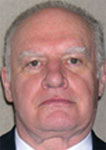 The longest-lasting and probably most important battle in the multi-front war against terrorism is against three invisible enemies: radiological, biological and chemical weapons. To help combat these lethal threats the U.S. and allied private sectors have developed and are producing a broad range of detection systems and sensor devices designed to find and identify a broad spectrum of deadly assassins that – if not contained, quarantined, and destroyed – could kill thousands and perhaps millions of innocent victims. The following Special Report focuses on a few of those systems and devices – built by such leading-edge companies as ADVNT Biotechnologies, CANBERRA Industries Inc., Innovative Biosensors Inc., ICx Technologies, MSA, PROENGIN Inc., and Thermo Fisher Scientific.
The longest-lasting and probably most important battle in the multi-front war against terrorism is against three invisible enemies: radiological, biological and chemical weapons. To help combat these lethal threats the U.S. and allied private sectors have developed and are producing a broad range of detection systems and sensor devices designed to find and identify a broad spectrum of deadly assassins that – if not contained, quarantined, and destroyed – could kill thousands and perhaps millions of innocent victims. The following Special Report focuses on a few of those systems and devices – built by such leading-edge companies as ADVNT Biotechnologies, CANBERRA Industries Inc., Innovative Biosensors Inc., ICx Technologies, MSA, PROENGIN Inc., and Thermo Fisher Scientific.
ProStrips 5 – The Key to Success, In Real-Life White Powder Incidents
Speed, reliability, and accuracy are the qualities most needed by first responders “to quickly detect a credible white powder” and are the principal stock in trade of ADVNT Biotechnologies, a specialized but internationally respected biotech company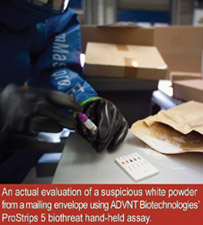 headquartered in Phoenix, Arizona. ADVNT’s line of “quality rapid-detection products,” which company spokesman Dan Faubion notes have been successfully evaluated by the U.S. Department of Defense and the Ministry of Defense in the UK, are currently used by the FBI, the U.S. Secret Service, the U.S. Border Patrol, all branches of the United States military and several of its allies, and “even NASA.”
headquartered in Phoenix, Arizona. ADVNT’s line of “quality rapid-detection products,” which company spokesman Dan Faubion notes have been successfully evaluated by the U.S. Department of Defense and the Ministry of Defense in the UK, are currently used by the FBI, the U.S. Secret Service, the U.S. Border Patrol, all branches of the United States military and several of its allies, and “even NASA.”
Significantly, ADVNT’s products also are being used to train military, medical, hazmat, and other security personnel not only at major military facilities in the United States but overseas as well.
According to Faubion: ADVNT develops, manufactures, and markets “sophisticated yet simple-to-use” HHA (hand-held assay) devices that can detect and identify a variety of threat agents “in as little as three minutes.” “Our detection tests require a “very small sample,” and are very specific, he said. These devices “are not a simple protein test that merely detect an organic material.”
The newest addition to the ADVNT line is ProStrips 5, “the only device in the world,” Faubion points out, “capable of detecting five BW agents simultaneously: anthrax, ricin toxin, botulinum toxin, Y. pestis/plague, and SEB.” ProStrips uses “one sample, one device,” to “rapidly detect” all of these potential threats and to provide “highly accurate information to the user. … Nothing is easier, more accurate, or less expensive than ProStrips 5.”
From a marketing point of view, one of ADVNT’s biggest selling points is that its products already have been used in a number of real-world “White Powder Incidents,” including the well publicized recent discovery of ricin toxin in a Las Vegas hotel room. The Las Vegas police department “used our tests to successfully identify the ricin,” said Faubion.
Forty Years, a Global Presence and Falcons for the Future
CANBERRA has been the world’s leading supplier of radiation detection, identification, and protection systems, instruments, and services for over 40 years, and, in the 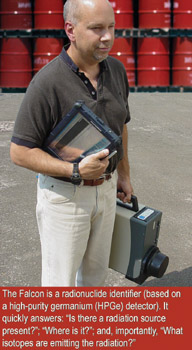 words of Marketing Manager Regis Lacher, offers solutions that “cover the entirety of radiation-detection needs” ranging from the protection of first responders to the use of “scanning technologies” to protect the ports and borders of the United States and its allies throughout the world.
words of Marketing Manager Regis Lacher, offers solutions that “cover the entirety of radiation-detection needs” ranging from the protection of first responders to the use of “scanning technologies” to protect the ports and borders of the United States and its allies throughout the world.
CANBERRA’s long list of satisfied customers includes not only the U.S. Department of Defense and U.S. Department of Energy but also a number of state, local, and federal law-enforcement agencies and several international organizations and several allied military forces. It is no secret that the company’s inventory includes numerous fixed, mobile, and portable detection devices that are used to identify the presence of radioactive materials concealed in packages, containers, and vehicles of all types – and on people. The principal goals of all of the company’s customers, Lacher says, are much the same: to prevent the diversion of radioactive materials; to interdict the smuggling of nuclear weapons or devices; and to mitigate “the consequences of radiological events.”
Looking to the future, Lacher says that “one way” that the U.S. (and global) radiation-measurement industry is likely to change in the next several years is through “an increased acceptance of and reliance on novel technologies such as High-Purity Germanium-based radiation detection.” He cites CANBERRA’s own Falcon 5000 ™ portable radionuclide identifier [www.canberra.com/products/438118.asp] as a leading example. The Falcon, he said, provides: (a) High Resolution – achieved by combining “the best-resolution HPGe technology with ultra-low microphonic cooling”; (b) Proven Software – The Falcon system “comes complete with a full version of … [the company’s] industry-leading gamma analysis software, Genie 2000”; and (c) Ease of Use – “The user can easily review the contents of any … nuclide library and even edit the current library or load a different one as the application requires.”
A Desert Storm Veteran Emphasizes AP4C Capabilities
One of the world’s best known and most highly respected builders of biological/chemical detection systems and devices is PROENGIN Inc., a French company (its U.S. offices are headquartered in Plantation, Florida) that specializes in the development, design, and delivery of easy-to-use and highly reliable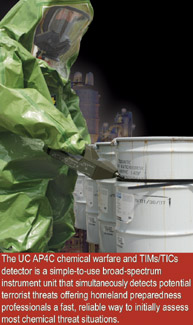 flame-spectrometry systems that were used by the French Army during Operation Desert Storm – and since then have been sold to more than 40 other countries.
flame-spectrometry systems that were used by the French Army during Operation Desert Storm – and since then have been sold to more than 40 other countries.
The company’s distinguished roster of satisfied customers includes, in addition to the armed services of most of those same countries, the U.S. Department of Homeland Security and a long list of fire departments, HLS, law-enforcement, EMS (emergency medical services), and public-health offices and agencies in nations throughout the world.
Fast response times, exceptional reliability, very high sensitivity, and easy maintainability are among the principal virtues of the PROENGIN detection systems, according to General Manager Mark Reuther, who points out that, of 8,000 units of one of its principal systems now in service, fewer than 10 per year malfunction in any way and have to be returned.
The current “star” of the company’s product line is the AP4C chemical-warfare and TIMs/TICs (toxic industrial materials/toxic industrial compounds) detector that offers homeland-preparedness professionals a fast and reliable way to carry out quick and accurate assessments of most “potential terrorist threat” situations. The “simple-to-use” AP4C, Reuther notes, is effective against “all vomiting agents,” “all nerve agents” (Sarin, soman, and Vx, for example), “all blood agents,” and “all blister agents” (e.g., mustard gas and lewisite).
Asked if a first responder would be better off using “a broad-spectrum detector with a very high potential to indicate the danger and its source [the AP4C, in other words],” or a detector “that has limited detection capabilities and offers identification – but will not detect any threat not included in its identification programming,” Reuther’s answer was short, succinct, and very much to the point: “Determining if a threat exists should [always] be the first step.” Specific identification of the threat, he continued, “can follow after the area has been secured.”
A CEDAP Win, On-Sites, and an Edgewood Pedigree
A false-positive rate of one in one million, a false-negative rate of one in ten thousand, and the exceptionally accurate identification of such deadly biopathogens as anthrax, ricin, the plague, and smallpox. Those are among the many working qualities that make MSA detection/identification systems and devices so popular with 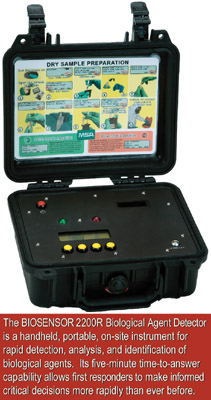 the U.S. and allied armed forces and with state, federal, and local CBRNE (chemical, biological, radiological, nuclear, explosives) military and hazmat teams.
the U.S. and allied armed forces and with state, federal, and local CBRNE (chemical, biological, radiological, nuclear, explosives) military and hazmat teams.
The assays provided by MSA devices are not only extremely sensitive but also, according to CBRNE Marketing and Sales Director Norman Davis Jr., designed to provide, “to an extremely high certainty,” the on-the-scene identification of a large number of biological agents and toxins. That value-added capability, he notes, gives hazmat teams the ability to “quickly determine whether to clear and/or quarantine an office building, sporting event, or other venue, and – of even greater importance – to know what prophylactics should be provided to those who have been exposed to whatever dangerous agent has been identified.”
The handheld BIOSENSOR 2200R, developed in cooperation with the Edgewood (Md.) Chemical/Biological Center and intended specifically to serve as a portable field unit, is the latest weapon in the company’s anti-pathogen toolkit. Well designed with an onboard menu-driven instruction set and lid-mounted pictorial “quick-start” guide, it is not only lightweight and easy to use but also able to preserve test samples for additional testing later in a permanent lab.
Adding further luster to MSA’s already glowing reputation was the company’s selection earlier this year, by the Department of Homeland Security, for a major CEDAP (Commercial Equipment Direct Assistance Program) bio-detection contract. The CEDAP selection process, Davis noted, is a “highly competitive” one in which DHS subject-matter experts evaluate a number of excellent systems and devices. “Being selected for CEDAP,” he said, “is a significant endorsement [of BIOSENSOR] as a world- instrument that meets the needs of first responders in both law enforcement and the fire services.”
Diversity, Versatility, Strength and an Unobtrusive Stanchion
ICx Technologies, one of the most innovative and successful companies in the domestic-preparedness field, has already built numerous detection systems and devices that are used today by the nation’s armed forces, and by law-enforcement agencies throughout the country – as well as many private-sector organizations – to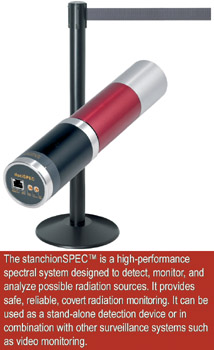 protect the U.S. homeland, and American citizens, not only from new terrorist attacks but also from a broad spectrum of other threats.
protect the U.S. homeland, and American citizens, not only from new terrorist attacks but also from a broad spectrum of other threats.
ICx detection systems of various types are now being used for the protection of not only airports (in Houston, for example, and in Seattle-Tacoma, Washington), and seaports (Long Beach, San Diego, and Orlando), but also such “critical facilities” as the Statue of Liberty, the Pentagon, and a number of U.S. Army depots). The company’s customer list also includes not only all branches of the U.S. armed forces and the Israeli Defence Force, but also: (a) In the law-enforcement field, the California Department of Corrections and more than 50 police and sheriff offices throughout the United States; (b) In the transportation field, the Panama Canal, the California and Hawaii Departments of Transportation, and the Washington (D.C.) Metro Area Transit Authority; and (c) In the field of border security, both the U.S. Customs and Border Patrol and Israeli border-surveillance units on station along the Gaza Strip.
The company’s principal strength, perhaps, according to Patrick Dempsey, ICx’s vice president for Detection Sales, “is its diversity across the homeland-security spectrum.” Its adaptability, he added, is another major selling point. “Our solutions to the market’s problems can be scaled to the right size for the job.” The ICx Detection Division, he pointed out, builds products “for every segment of the CBRNE [chemical, biological, radiological, nuclear, explosives] field. We have devices that quickly detect CBRNE agents within minutes.”
ICx is not resting on its laurels, though. One of its newest and most versatile offerings, in Dempsey’s words, is “a radiation detection/identification product called the stanchionSPEC that was specifically designed to detect, monitor, and analyze possible radiation sources. Built into a standard crowd-control stanchion to give security professionals a way to unobtrusively create an array of monitoring stations, it can be used to detect and identify radioactive sources that may be used in weapons of mass destruction.” The stanchionSPEC “can be set up quickly in almost any location,” Dempsey continued, “and can be used as a stand-alone detection device or in combination with other surveillance systems – video monitoring, for example.”
Disposable Discs and Aptly Named CANARY Capabilities
Innovative Biosensors Inc. (IBI) – the key word in that name is “Innovative” – combines imagination, energy, and a clear sense of purpose in its quest to develop and build a versatile line of bio-detection systems and devices that provide high value at relatively low cost. Focusing on end-to-end solutions that encompass not only biological aerosol sampling but also the collection, detection, and identification of 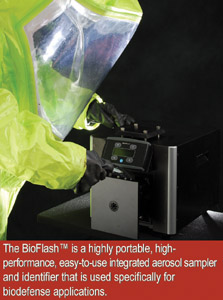 pathogens, the company emphasizes both affordability and efficiency in its easy-to-use products.
pathogens, the company emphasizes both affordability and efficiency in its easy-to-use products.
Probably the best known of those products is IBI’s BioFlash™ biological aerosol sampler and identification system, which offers an integrated biological aerosol sampler and detector, that can be used for the rapid and sensitive identification of a potential biological threat. “The BioFlash biological detector,” says Richard R. Thomas, president of the company’s Environmental Group, “is a highly portable, high-performance, easy-to-use integrated aerosol sampler and identifier that was created specifically for biodefense applications.”
The BioFlash detector, which incorporates the aptly named CANARY (Cellular Analysis and Notification of Antigen Risks and Yields)* diagnostic technology developed by MIT Lincoln Laboratory scientists, provides sensitive and specific identification of up to 21 biological threat agents, including but not limited to Bacillus anthracis spores, Yersinia pestis, Francisella tularensis, VEE, and vaccinia as well as botulinum toxin and ricin. Recent government aerosol testing, Thomas said, “has validated the BioFlash breakthrough sample collection efficiency and speed of detection.” [*Canaries used to be carried into coal mines to provide an early warning of potentially fatal gases.]
The use of simple disposable plastic disks permits the BioFlash to simultaneously collect and identify up to 21 biological threat agents. According to Thomas, the system detects and identifies bacteria, viruses, and toxins in the air in less than three minutes with sensitivities approaching those of polymerase-chain- reaction (PCR) detectors at a fraction of the cost. The BioFlash technology is now being deployed in a number of buildings, Thomas said, to provide accurate and rapid biological agent threat detection and identification.
RadEye, Hand-Held Devices And Entirely Integrated Solutions
“A complete line of high-sensitivity instruments and devices” specifically designed for use by U.S. and allied defense and law-enforcement agencies and organizations “to detect illicit radioactive materials and to monitor ... [suspect] areas for radioactivity.” That is the noble goal, briefly summarized, and mission set for itself by Thermo Fisher Scientific, which designs, develops, and builds a full range of products, ranging from hand-held devices to “entirely integrated solutions,” that serve “the entire radiation-measurement needs” of U.S. homeland-security professionals.
At the top of the company’s product list, according to Adam Grose – general manager of Thermo Fisher Scientific Radiation Measurement and Security Instruments – is the RadEye product family. RadEye can be used not only “as a prevention and detection device before, during, and after a radiation event,” he told DPJ, but also as a preventive device to help the first-responder community carry out its surveillance duties.
“During a radiation-related event,” he continued, first responders “can use the RadEye to detect airborne radiation while being secure in the knowledge that the RadEye will not provide false alarms” (triggered by naturally occurring background radiation). RadEye “delivers radiation detection, gamma dose-rate measurement, and area monitoring in a convenient, pocket- sized instrument,” Grose said.
In addition to its RadEye products, he added, the company “markets a broad range of environmental instruments that can comprise a whole homeland- protection system, including air-, water-, and radiation-monitoring instruments and integrated systems.” Its radiation measurement and protection products, he continued, “provide unequalled radiologic performance and protection.”
